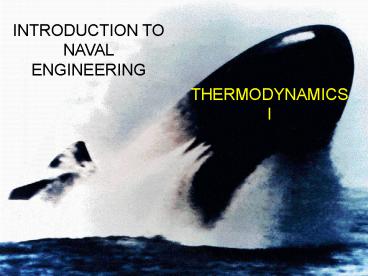Engineering Lesson Guide 2
1 / 24
Title:
Engineering Lesson Guide 2
Description:
THERMODYNAMICS. I. INTRODUCTION TO. NAVAL. ENGINEERING. ENERGY ... THERMODYNAMICS: The science concerned with the inter-relationship between thermal energy and ... –
Number of Views:43
Avg rating:3.0/5.0
Title: Engineering Lesson Guide 2
1
INTRODUCTION TO NAVAL ENGINEERING
THERMODYNAMICS I
2
INTRODUCTION TO NAVAL ENGINEERING
ENERGY AND HEAT TRANSFER
3
THERMODYNAMICS
- The science concerned with the inter-relationship
between thermal energy and mechanical energy
4
WHAT ARE THE TYPES OF ENERGY?
- Stored
- Potential (based on position)
- Kinetic (based on velocity)
- Transitional
- Energy that is in the process of being
transferred from one object or system to another.
All energy in transition begins and ends as
stored energy
5
HOW CAN KINETIC ENERGY BE STORED ENERGY?
- Definition of energy
- the ability to produce an effect
- The Bullet example
- Has the capability for an effect
- But it needs something to hit in order to
transfer that energy (the effect)
6
MECHANICAL ENERGY
- Potential Energy (PE)
- PE mgh
- Kinetic Energy (KE)
- KE (1/2)mV2
- Mechanical Energy in TRANSITION
- Called Work
- Wk FD
7
THERMAL ENERGY
- Stored Thermal Energy Called Internal
- Internal Potential Energy
- Associated with the force of attraction that
exist between molecules. - Internal Kinetic Energy
- Associated primarily with the activity of the
molecules - Thermal Energy in TRANSITION
- Called Heat
- Requires a temperature difference between two
systems
8
MEASURING THERMAL ENERGY
- In the real world we use CALORIES and JOULES
but... - BRITISH THERMAL UNIT
- Quantity of Heat required to raise the
temperature of 1 lbm of water from 50.9F to 60.9F - Please dont write that down
9
MODES OF HEAT TRANSFER
10
(1) CONDUCTION
- Heat flows from hotter to colder region when
there is physical contact between the regions
11
CONDUCTION (cont.)
- The total quantity of heat passed
- is proportional to the cross-sectional area of
the conductor over a given time - is proportional to the time of heat flow
- in a given length of time is proportional to the
thermal gradient (temp difference) - depends on the thermal conductivity of the
substances
12
GENERAL CONDUCTION EQUATION
- Q kTA (t1-t2)/L
- where
- Q Quantity of heat (Btu or cal)
- k Coefficient of thermal conductivity
(Btu/((hr)(F)(ft)) - T Time (hr)
- t1 Temp at hot end (F)
- t2 Temp at cold end (F)
- L Distance between the two ends (in)
- A Cross sectional area (sq ft)
13
CONDUCTION EXAMPLE
LENGTH
HOT
COLD
AREA
14
(2) RADIATION
- Mode of heat transfer that does not involve any
physical contact between the emitting and
receiving regions
15
(3) CONVECTION
- The mechanical transportation of a mass of fluid
from one place to another - Beyond the molecular level
- Movement of fluid within fluid
- Transportation, not transfer
- Fluids thermal energy remains in stored form
unless it is transferred by radiation or
conduction
16
CONVECTION (cont)
- TWO TYPES OF CONVECTION
- Natural
- Occurs when there are differences in the density
of different parts of the fluid. The difference
in density are usually caused by a temperature
difference. - Forced
- Occurs when some mechanical device, such as a
pump or a fan, produces movement
17
DEFINITIONS
- Sensible Heat
- When heat added results in the change in
temperature (kinetic energy) - Latent Heat
- When the heat added results in a physical change
of the substance (potential energy) - Saturation Temperature/Pressure
- Psat/Tsat
- The point at which liquid and vapor may exist in
equilibrium contact with each other
18
DEFINITIONS (cont)
- Saturated Liquid/Vapor
- A liquid/vapor at a specified pressure which is
at Tsat for the pressure - Wet vapor
- Subcooled Liquid
- A liquid at that specified pressure which is
below the Tsat - Superheated Vapor
- A vapor that has been raised above Tsat for a
given pressure
19
DEFINITIONS (cont)
- Latent Heat of Vaporization
- Amount of heat necessary to change a mass of
liquid to vapor without changing the temperature - Latent Heat of Fusion
- Amount of heat that must be added/removed to a
unit mass to melt/solidify it
20
(No Transcript)
21
GENERAL CONDUCTION EQUATION REVISITED
- Q kTA (t1-t2)/L
22
TYPES OF HEAT EXCHANGERS
Parallel Heat Exchanger
Counterflow Heat Exchanger
23
TYPES OF HEAT EXCHANGERS
Crossflow Heat Exchanger
24
FACTORS FOR K
- THE BOUNDARY LAYER
- SCALE/CHEMICAL DEPOSITS
- SOOT/DIRT BUILDUP































